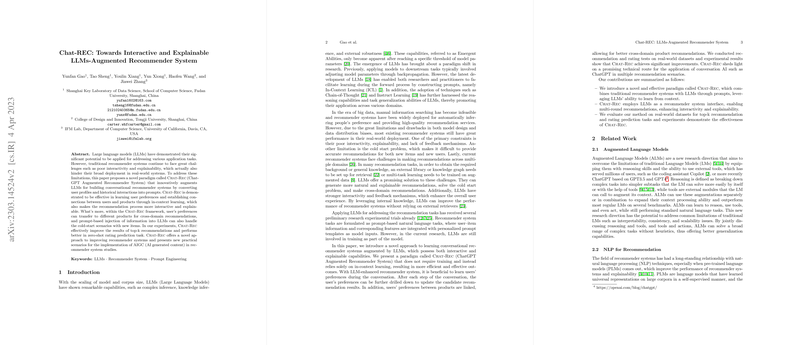Overview of Chat-REC: LLMs-Augmented Recommender System
The paper "Chat-REC: Towards Interactive and Explainable LLMs-Augmented Recommender System" presents an innovative approach to enhancing the capabilities of traditional recommender systems using LLMs. This method, named Chat-REC, integrates LLMs' potential to improve interactivity and explainability, two persistent limitations of conventional systems. By converting user profiles and interaction histories into prompts for in-context learning, Chat-REC enables LLMs to effectively capture user preferences and make personalized recommendations.
Key Contributions
- Novel Integration of LLMs and Recommender Systems: Chat-REC proposes the use of LLMs not as models requiring fine-tuning or parameter optimization, but as systems that enhance recommendation tasks by leveraging their context learning capabilities. This paradigm shift departs from traditional recommender systems that rely heavily on adjusting model parameters and instead focuses on prompt-based knowledge incorporation.
- Enhanced Interactivity and Explainability: By integrating conversational AI frameworks, Chat-REC improves user interaction, allowing for dynamic recommendation adjustments and providing explanations for recommendations. This addresses critical issues in existing systems where static and opaque recommendations often lead to suboptimal user satisfaction.
- Cross-Domain and Cold-Start Solutions: The system deftly handles cold start scenarios, recommending new items by using LLMs' background knowledge and prompt-based information injection. It also extends recommendations beyond single domains, using relationships identified by LLMs to suggest items across various categories like books, music, and movies.
- Experimental Validation: Using the MovieLens 100K dataset, the authors demonstrate that Chat-REC significantly outperforms traditional systems like LightFM, LightGCN, Item-KNN, and Matrix Factorization in tasks including top-k recommendation and rating prediction. Notably, models such as text-davinci-003 in the Chat-REC framework showed substantial improvements in both precision and NDCG scores, confirming the effectiveness of in-context learning.
Implications and Future Directions
The implications of Chat-REC are manifold, both theoretically and practically. Theoretically, it provides evidence that LLMs can serve effectively in domains beyond natural language understanding and generation, enhancing systems traditionally not reliant on language data. Practically, the approach offers pathways to more robust and user-friendly recommender systems, aligning technological advances with user expectations.
Moving forward, future developments could explore optimizing the interaction between structured and unstructured data in recommendation contexts. Additionally, examining how LLMs can handle real-world constraints such as privacy concerns and data sparsity could further bolster chat-recommendation systems' practicality.
In conclusion, Chat-REC exemplifies an effective amalgamation of LLM capabilities with traditional recommendation tasks, establishing a baseline for the development of more interactive and explainable recommendation systems in the future.
